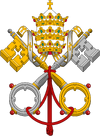- Main article: Eucharist (Catholic Church)
In the Catholic Church, concelebration (from Lat., con + celebrare,to celebrate together) is the presiding of a number of priests at the celebration of the Eucharist with either a priest or bishop as the principal celebrant and the other priests and bishops present in the sanctuary assisting in the consecration of the Eucharist. The concelebrants assist the principal celebrant by reciting the Words of Consecration together with him, thus effecting the transubstantiation of the eucharistic elements.They may also recite portions of the Eucharistic Prayer. This article treats principally of the practice in the Latin Rite within the Roman Catholic Church.
History[]
Concelebration is and has always been common in Eastern Christianity, but in the Roman Catholic Church the practice fell into disuse for several centuries but has been revived with the liturgical reforms of the Second Vatican Council.
Concelebration in the Latin Rite[]
It is known from early Christian art uncovered through archaeology that concelebration took place in the Early Church in West, although it is not known precisely when it fell into disuse. It is known that the practice gradually came to be reserved for the greater festival days and other solemn occasions. According to Pope Innocent III (r.1198-1216) the cardinals in Rome still concelebrated with the pope on certain feast days. It is known that from the medieval period (particularly following the Black Death when masses for the dead celebrated daily by all priests became the norm (with the exception of the Sundays). By the Second Vatican Council there were only two occasions when concelebration took place in the Roman Rite:
1) At the ordination of a priest, where the newly ordained concelebrated with the ordaining bishop, and
2) At the consecration of a bishop, when the newly consecrated bishop concelebrated with the consecrating bishop.
The liturgical reforms which took place following the Second Vatican Council included the provision for the return to the practice of concelebration of masses. Thus, communities with more than one priest could have several priests concelebrate the Eucharist rather than each celebrating it in private, emphasizing its communal nature. Liturgical law allows concelebration on any occasion, but it is more common at festivals, especially those at which the bishop traditionally presides, such as the Chrism Mass on Holy Thursday.
References[]
- Catholic Encyclopedia Concelebration
| |||||||||||||||||
